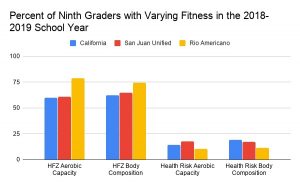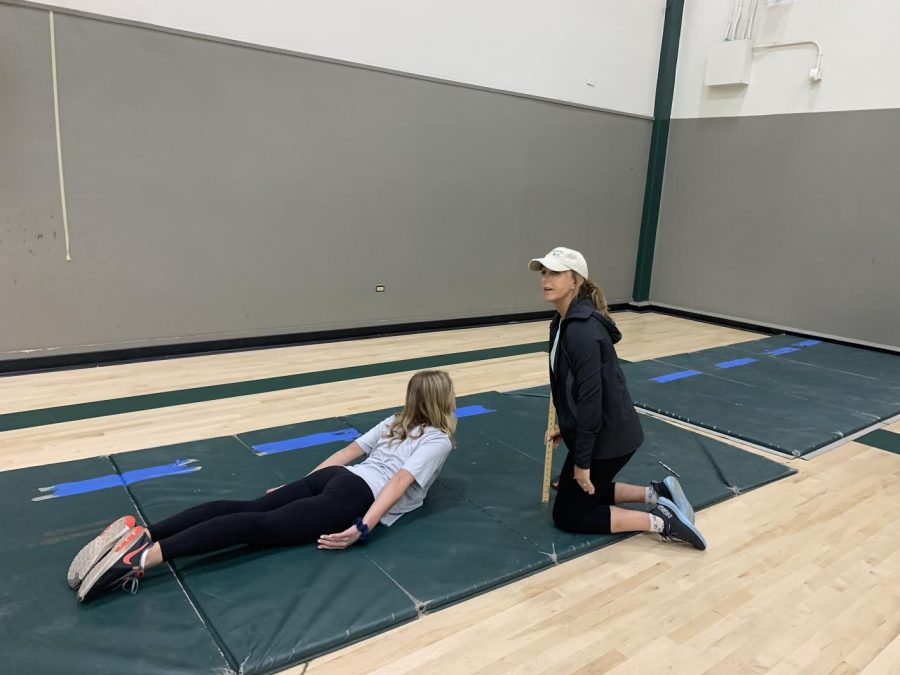California Fitness Testing
March 24, 2020
California’s Fitness tests are unfair for some. But stopping the tests could prove disastrous.
Calif. Governor to Postpone Fitness Testing for P.E.
Photo By Nicolas Gorman
P.E. teacher Shawna Virga measures a students performance in the trunk lift exercise.
A three sport varsity athlete could fail the trunk lift. A transgender student could be in the healthy fitness zone for pushups in their gender at birth but not their self-identity.
A nonbinary student could feel targeted having to calculate their body mass index. An obese student could lose motivatio after failing the pacer test.
Complaints such as these have prompted Gov. Gavin Newsom to consider stopping fitness tests for two years in order to reformat the evaluation of student health.
Physical Fitness Tests (PFTs) are currently administered to grades five, seven and nine. The California Education Code implemented PFTs in order to provide information that can be used by students, parents and teachers to assess health, plan fitness programs, design curriculum and monitor students changes in fitness levels.
P.E. teacher and head track coach Trevor Boler believes the general idea of fitness testing is good, but it doesn’t always match up to a student’s goals or what their healthy interests should be.
“The individual needs to find motivation and if you don’t pass a certain fitness test that’s okay as long as you’re working on your motivation,” Boler said.
The fitness tests survey multiple components of fitness including muscular strength, aerobic capacity, flexibility and body composition. Part of the issue addressed by Newsom’s proposal to end such tests is concerns with gender identity and body composition.
The common evaluation of body composition is done by taking Body Mass Index; however this screening is delicate for some students as it gives two options – male or female – to judge if their BMI is in a healthy range, or the Healthy Fitness Zone (HFZ).
Counselors at Rio Americano, however, report that they have never received complaints regarding PFTs.
Senior Samantha Klein values the fitness tests, but agrees they could be revised.
“I think that fitness tests are important and a good way to make sure young children stay in shape,” Klein said. “However, I think that they could improve it in some ways so they do not face the gender and obesity problems they are facing.”
Although language used to categorize student’s results is neutral, there is still a degree of comparison that is worrying to some. The tests place students in one of three categories; HFZ, Needs Improvement and Needs Improvement – Health Risk.
Historically, Rio Americano has produced healthier results than that of the state of California, and the San Juan Unified School District.
In the 2013-2014 school year, the state of California tested over 435,000 ninth graders using the PFT. While the majority of students were in the HFZs for aerobic capacity and body composition, 12.7 percent and 16.8 percent in their respective categories were in the Health Risk classification.
Contrarily, at Rio Americano, 11.6 percent of the 429 ninth grade students reflected unhealthy levels of aerobic capacity and 13.1 percent had health risks for body composition.

Furthermore, the amount of students needing improvement in California has increased the past five years, while at Rio the numbers have decreased.
In 2018-2019, the proportion of California students in the Health Risk category increased to 17.6 percent and 23.5 percent for aerobic capacity and body composition, respectively.
At Rio, these values decreased to 10.4 percent for aerobic capacity and 11.5 percent for body composition, widening the gap between the state and school’s results.
In Boler’s P.E. classes, passing these tests are not taken into consideration to a student’s grade, to respect students who may be self conscious about their results.
“There’s certain areas that are important, however an individual’s needs are more important than the categories of fitness testing,” Boler said. “If a student is overweight they should be worried more about health not necessarily passing a test.”
While research has not been conducted as to pinpoint why Rio has overall healthier results, a separation of economic status influences these numbers.
The 429 ninth graders tested at Rio from the 2013-2014 school year increased by almost 20 percent to the 2018-2019 school year, while the amount of economically disadvantaged students at Rio only increased 10.8 percent. This makes it seem as if economic status has an inverse relationship with poor health; as economic status decreases, students displaying health risks increase.
The overall state numbers, however, contradict this trend. In the state of California, the amount of ninth graders tested increased three percent but the amount of economically disadvantaged students decreased one percent from 2014 to 2019, despite a gradual shift away from the HFZ.
Those who oppose Governor Newsom’s proposal to end PFTs point out the rising health issues among California adolescents, claiming the fitness tests provide important insight to where the state stands in teen health.
Junior Gianna Nocetti points out it is better to be aware of student’s health when they are young.
“I think fitness tests are important and they shouldn’t get rid of them,” Nocetti said. “It’s important to encourage healthy lifestyles early on.”
The proposition to halt fitness tests emerged from Newsom’s plan to divide and execute next year’s $222.2 billion budget proposal. The proposal also includes a possibly beneficial emphasis on nutrition in school lunches, led by Newsom’s wife.
Upon approval, Newsom requests that education leaders deliberate with adept fitness, gender identity and disability professionals to recommend how to proceed with PFT so that state schools can advise lawmakers and the State Board of Education by late 2022.
Problems in California’s Fitness Testing
Photo By Nicolas Gorman
PE Teacher Shawna Virga measures a student’s performance in the trunk lift for freshman fitness testing.
The fitness test was originally created to monitor fitness levels of students, but many believe that the current program needs to be changed. This would be focused on reducing the amount of body shaming that has occured from the current test and to help include students who don’t identify with the traditional genders.
The test currently measures a person’s flexibility, strength, body composition and aerobic capacity. Some tests like flexibility are obscure; the test requires students to be able to place one hand behind their head and back over the shoulder, and place the other arm behind their back reaching up as far as possible attempting to touch or overlap the middle fingers of both hands.
The issue with stopping the test for two years is that there would be a gap in the data for schools. This gap would make it harder for schools to address any health concerns that students may have.
The idea of reforming the fitness test sounds ideal but there is the possibility that there will now be a lack of health consciousness amongst school children without the fitness tests. Not every household teaches the importance of healthy living by eating healthy or going outside and getting exercise, learning and developing these habits is important.
With social media being an overwhelming factor in most teens’ lives, bullying and body shaming has become a part of society and with the test focusing on the body. It would be great to see schools make real reforms and show its students that school is a safe environment where body shaming is not allowed.
Another issue with the test is that there are only two gender options, male and female. In today’s society some people identify as non-binary (someone that falls somewhere in the middle of the gender spectrum and are neither strictly male or female), or Agender (Not identifying with any gender) which the test doesn’t take into consideration.
The reforms proposed by Newsom would deal with these issues and states that he would consult experts in physical fitness, and gender identity to make sure that the reforms are effective. He has yet to release what the test would be for the three year interim period.
Governor Newsom should reform the test because there is no point in doing a test that isn’t accurate. The test was meant to monitor and teach students about fitness but when it no longer serves its purpose then you have to change the test to be effective for both students and schools.


